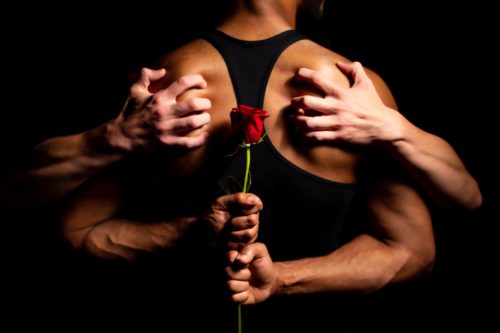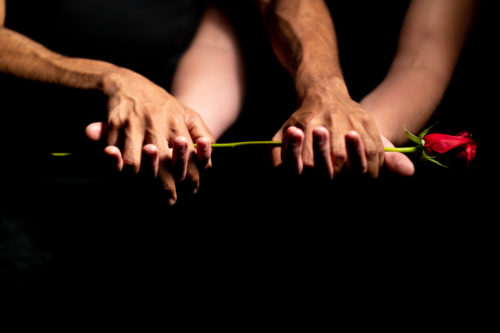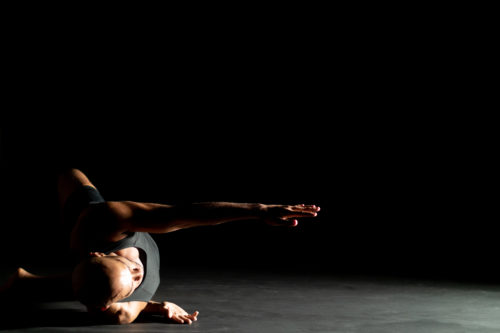Gentle/Men – John Beasant and Dancers

All photos by John Beasant III
The notion of men dancing is often met with mixed reactions, not equally positive and negative. In too many cases, a presumption of homosexuality is made—and indeed, there is a history of prominent gay male dancers. Many male dancers report the awkwardness of often being the only male in a dance class, or at least often being in the minority. Exploring, enhancing, and celebrating the male in dance, both in ability and in reputation (however you want to deconstruct that) go back in the United States at least to the 1930s with Ted Shawn and His Men Dancers. There have been documentaries on boys in dance and there is an annual Male Dancer Conference. There are many reasons (which you may easily research via Google) for moments of male dancers coming together.
Because I have an interest in this subject (particularly in Ted Shawn’s life and experience), I was eager for the performance of Gentle/Men, the first full-length evening of work in Houston by dancer and choreographer John Beasant. The press release spoke of celebrating men in dance but also of expressing femininity as well as masculinity. A company of ten men exploring all that created no little interest in my little gay heart. Having said that, I’ve also learned to approach shows with few expectations and wait to see what the artists have to show and tell me.
 First, general notes: in this one hour program, there were eight sections: The Rising, The Hurting, The Loving, The Breaking, The Blooming, The Rooting, The Wilting, and The Healing. Along the front of the stage were set six tall, thin, glass vases. Between each section, Alonzo Lee Moore IV entered the stage carrying a long-stemmed rose, reciting poetry by Rupi Kaur and placing the rose in a vase. The dancers all wore form-fitting red shorts and black sleeveless shirts throughout the program.
First, general notes: in this one hour program, there were eight sections: The Rising, The Hurting, The Loving, The Breaking, The Blooming, The Rooting, The Wilting, and The Healing. Along the front of the stage were set six tall, thin, glass vases. Between each section, Alonzo Lee Moore IV entered the stage carrying a long-stemmed rose, reciting poetry by Rupi Kaur and placing the rose in a vase. The dancers all wore form-fitting red shorts and black sleeveless shirts throughout the program.
Those coming to see hyper-masculine movement (a la Shawn’s “men can dance!” aesthetic) or a queering of gender expectations were met with something decidedly in the middle. There were, indeed, feats of strength that might be construed as very masculine, and there were moments of tenderness and intimacy that might be interpreted as queer—or possibly models for straight male connections. The wonder and joy of dance (for me, at least) is this ambiguity.
Not that it was all ambiguous. The section entitled The Rooting was the most romantic of the pieces. A duet between Derek Nicholson and Davis Stumberg, it started with the two in a social dance sort of embrace, as you might see in a ballroom setting. They break from this and engage in more modern or contemporary dance partnering. They move back and forth between the two styles throughout the dance. A recorded voice answers the self-presented question, “Why do I love you?” It would take some mental gymnastics to not interpret this as a presentation of same-sex love, particularly when it ends with the two almost kissing. That the kiss isn’t consummated in the light doesn’t leave much room for hetero-normative interpretations.
 But then we have the section, The Loving, which one might expect to be the most romantic. Another duet, this one was between Jaime Garcia and Joseph Stevens. The dancers created right angled boxes with their bodies and then rolled into another box, and then another, across the stage. There were feats of strength, for example a remarkable one-armed lift overhead, but also leaps and some brief moments of struggle. The final tableau found the two men holding hands and swaying as the lights faded, but I wouldn’t be certain it was a romantic love sort of hand holding. Everything that came before it suggested it may have been the love of connection between humans. This Loving was angular, strong, a little confrontational, but didn’t read to me as necessarily romantic or sexual.
But then we have the section, The Loving, which one might expect to be the most romantic. Another duet, this one was between Jaime Garcia and Joseph Stevens. The dancers created right angled boxes with their bodies and then rolled into another box, and then another, across the stage. There were feats of strength, for example a remarkable one-armed lift overhead, but also leaps and some brief moments of struggle. The final tableau found the two men holding hands and swaying as the lights faded, but I wouldn’t be certain it was a romantic love sort of hand holding. Everything that came before it suggested it may have been the love of connection between humans. This Loving was angular, strong, a little confrontational, but didn’t read to me as necessarily romantic or sexual.
The titles of the sections and the work presented in them sometimes worked in opposition to each other. One such section in particular was a solo danced by Beasant himself (his only appearance onstage). Entitled The Breaking, it found Beasant moving to up-tempo piano music. The feeling is light and happy, with skipping and running—a very playful piece that rubs up against the title unexpectedly. That the piece is dedicated to “the spritely spirit” of Beasant’s mother, who we learn in the “Special Thanks” program note died a mere five days before the start of this show’s run, added weight and depth to Beasant’s skipping, giving us insight to the breaking behind the playfulness.
A note on The Wilting is in order. It was presented as a projected video or film. Juan Ventura danced in a studio with a window. In the window was one of the glass vases with a long-stemmed rose in it. Ventura wore the same clothes every dancer wore in the live sections. One might question why this was presented as dance-for-film, but the main contrast was the lightness of the room, the natural light from the window and the white walls with a single line of red tape. It very much felt of a piece with the rest of the evening, but gave us a moment outside the black floor and curtains of the theater. There is a hard-to-name tension in the piece as Ventura danced, but I found the final gesture, after he pulled the red tape off the wall and faced the camera, satisfying. He raises one shoulder upward, and with his opposite hand pushes it down—a gesture I read as releasing his own tension, of giving himself permission to relax.
The evening opened and closed with group numbers, The Rising using seven dancers, The Healing employing six. Both were full-out contemporary choreography, with expert partnering and breaks into solos and duets. While I didn’t experience the evening as a single narrative or even a linear progression—I’m not sure if the order of the sections would have mattered in most cases—it was satisfying to see in the closing piece echoes of movement and themes from earlier in the program.
 The final sequence, in particular, was pleasing. Each dancer had a moment in a literal spotlight, a circle of white light. In a smaller, more amber circle just downstage, laid the roses, gathered earlier in the piece and dropped there. After each dancer had their “spotlight dance,” the next dancer entered the light to replace them and the previous dancer moved into another, new small, amber circle, until all dancers had their own small circle of light. The large one shrank down to contain the final soloist. Just before the black out, the six men extended their hands forward, elbows bent and by their sides, palms facing down. After the movement and strength and struggle and tenderness of the previous hour, it struck me as a posture of calm. They’d each found a moment of peace.
The final sequence, in particular, was pleasing. Each dancer had a moment in a literal spotlight, a circle of white light. In a smaller, more amber circle just downstage, laid the roses, gathered earlier in the piece and dropped there. After each dancer had their “spotlight dance,” the next dancer entered the light to replace them and the previous dancer moved into another, new small, amber circle, until all dancers had their own small circle of light. The large one shrank down to contain the final soloist. Just before the black out, the six men extended their hands forward, elbows bent and by their sides, palms facing down. After the movement and strength and struggle and tenderness of the previous hour, it struck me as a posture of calm. They’d each found a moment of peace.
In all, the audience that attended Gentle/Men witnessed an evening of skilled modern dance by a cast of excellent dancers. To confess my lie at the beginning of this review, I find I did have some sort of expectations. I must admit I didn’t expect how ultimately quiet the evening would be. As noted, an evening of all-men dancing could go in a few directions, but I was pleasantly surprised by the subtlety of the evening. I look forward to seeing more of John Beasant’s quietly surprising choreographic voice.



Great review Neil. I presume you’ve read “The Male Dancer”? It felt like you were referencing it in a couple of places but it’s been a while since I’ve read it myself. Wish I could have seen the concert. Sorry I missed it.
Thanks for the comment. I do have a copy of “The Male Dancer” on my shelf but I don’t think I’ve read every page of it. What I have read of it was many years ago, so I wasn’t directly referencing it, but after awhile, some ideas permeate and I don’t remember where I first encountered them. I’ve read a bit more on Ted Shawn and his Men Dancers (and I see a new biography is coming out late this year—on my wish list!) but I’ve also probably forgotten as much as I recall.